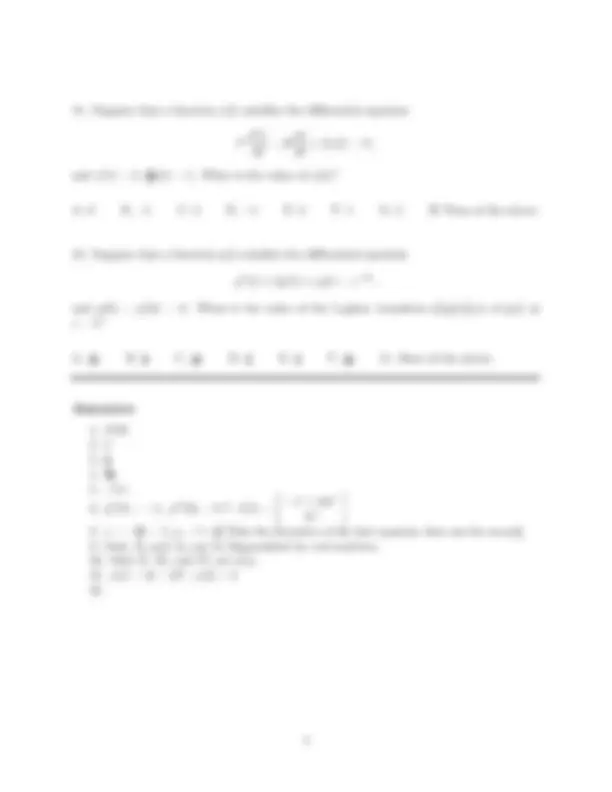





Study with the several resources on Docsity

Earn points by helping other students or get them with a premium plan


Prepare for your exams
Study with the several resources on Docsity

Earn points to download
Earn points by helping other students or get them with a premium plan
Community
Ask the community for help and clear up your study doubts
Discover the best universities in your country according to Docsity users
Free resources
Download our free guides on studying techniques, anxiety management strategies, and thesis advice from Docsity tutors
The final exam for math 240: calculus iii, consisting of eight long-answer questions and four multiple-choice questions. Students are not allowed to use books, calculators, or papers during the exam, except for a hand-written note card. Each long-answer question is worth ten points, and partial credits will be given for substantial work. The multiple-choice questions each carry the same weight.
Typology: Exams
1 / 5

This page cannot be seen from the preview
Don't miss anything!




This examination consists of eight (8) long-answer questions and four (4) multiple-choice questions. Each problem is worth ten points. Partial credits will be given only for long-answer questions, when a substantial part of a problem has been worked out. Merely displaying some formulas is not sufficient ground for receiving partial credits.
1 2 3 4 5 6 7 8 9-12 Total
Part I. Long-answer Questions.
C =
(x, y) : 4x^2 + 9y^2 = 36, x ≥ 0 , y ≥ 0
from (3, 0) to (0, 2). Compute the line integral ∫
C
(x + 1) dy + y dx.
(x, y, z) ∈ R^3
0 ≤ x, y, z ≤ 1
and let S = ∂D be the boundary surface of D, oriented by the unit normal vector field ~n on S pointing away from D. Compute the oriented surface integral ∫ ∫
S
(x^2 ~i + xyz ~j + z^3 ~k) · ~n dS.
S =
(x, y, z) ∈ R^3
x^2 + y^2 + z^2 = 1, z ≥ 0
the upper half of the unit sphere centered at the origin, oriented by the unit normal vector field ~n = x~i + y ~j + z ~k on S. Compute the surface integral ∫ ∫
S
(x~i − y ~j + z ~k) · ~n dS.
C
y dx − x dy x^2 + y^2
Part II. Multiple Choice Questions. Please circle your answer.
Which ones can be diagonalized over the real numbers? (In other words, there exists an invertible matrix P with coefficients in real numbers such that P −^1 · Ai · P is a diagonal matrix.)
A. A 1 and A 3 only B. A 2 , A 3 and A 4 only C. A 3 and A 4 only
D. A 2 and A 4 only E. A 1 , A 3 and A 4 only F. A 1 and A 4 only
G. A 1 , A 2 , A 3 and A 4
I. A must have four distinct eigenvalues.
II. There exists an invertible matrix C with real entries such that C · A · C−^1 is a diagonal matrix.
III. The four roots of the characteristic polynomial of A are all real numbers.
IV. A^2 is a symmetric matrix.
Which ones among the above statements are true?
A. I, II, III only. B. II, III, IV only. C. I, III, IV only.
D. III and IV only. E. II and III only. F. II and IV only.
G. I, II, III, IV are all true. H. None of the above.
t^2
d^2 x dt
− 2 t
dx dt
and x(1) = 3, dx dt (1) = 1. What is the value of x(2)?
A. 0 B. − 1 C. 3 D. − 4 E. 2 F. 1 G. 5 H. None of the above.
y′′(t) + 2y′(t) + y(t) = e−^2 t^ ,
and y(0) = y′(0) = 0. What is the value of the Laplace transform L{y(t)}(s) of y(t) at s = 1?
A. 121 B. 16 C. 241 D. 14 E. 13 F. 361 G. None of the above.
−et^ + 2tet 2 et